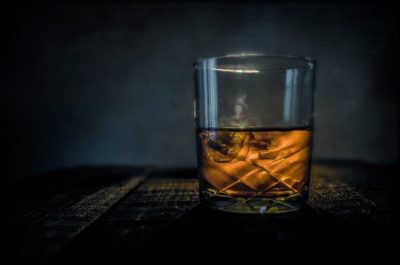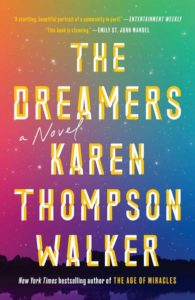 I took my first sip of bourbon at Thanksgiving. A few friends gathered for a Friendsgiving celebration and I was bringing dessert. I didn’t want to bring a traditional pie or cake. That was boring to me. I remembered seeing a book in our collection that had caught my eye – “Baked Elements: Our 10 Favorite Ingredients” by Matt Lewis and Renato Poliafito. The cover of the book is well done and inviting but it was the layout that really captured my attention and got me to look into it further. Each chapter of recipes is organized by the authors’ favorite ingredients that are found in many popular dessert staples such as peanut butter, caramel, cinnamon and chocolate. Chapter four is what got me curious – Booze. I knew that spirits are used in both cooking and baking but I hadn’t tried adding any to desserts that I’ve made in the past, so I was intrigued. The first recipe listed in the Booze chapter is Bourbon, Vanilla, and Chocolate Milk Shakes. That sounded, and looked, really good and super easy to do. I had my dessert!
I took my first sip of bourbon at Thanksgiving. A few friends gathered for a Friendsgiving celebration and I was bringing dessert. I didn’t want to bring a traditional pie or cake. That was boring to me. I remembered seeing a book in our collection that had caught my eye – “Baked Elements: Our 10 Favorite Ingredients” by Matt Lewis and Renato Poliafito. The cover of the book is well done and inviting but it was the layout that really captured my attention and got me to look into it further. Each chapter of recipes is organized by the authors’ favorite ingredients that are found in many popular dessert staples such as peanut butter, caramel, cinnamon and chocolate. Chapter four is what got me curious – Booze. I knew that spirits are used in both cooking and baking but I hadn’t tried adding any to desserts that I’ve made in the past, so I was intrigued. The first recipe listed in the Booze chapter is Bourbon, Vanilla, and Chocolate Milk Shakes. That sounded, and looked, really good and super easy to do. I had my dessert!
As I read the recipe, I saw that it called for “good-quality bourbon.” I had no experience with this spirit. I had no idea what “good-quality bourbon” was or even, how to find out. I was discussing my conundrum with a friend who knew his bourbon and could recommend a brand that would work for the recipe. It got me curious, though. I had never really considered using this spirit in any drinks or recipes before. I had made cocktails with vodka, gin, rum, and tequila but this was totally new to me and I wanted to find out more. I did what any self-respecting librarian would do—I searched our catalog. I simply typed in the term “bourbon.” After filtering out fiction titles and materials on the Bourbon Dynasty, I realized that there was a lot written about bourbon whiskey for those who wanted to be in the know.
I wanted to know which ones to try so I thought “Bourbon Curious: A Simple Tasting Guide for the Savvy Drinker” by Fred Minnick would be a good place to start. The author helps readers identify what type of bourbon they might be interested in trying by organizing them by flavor profile: grain, nutmeg, caramel and cinnamon. I knew I wanted one that would go well in a dessert, so I looked at the caramel and cinnamon sections in particular but found the whole book interesting. I also looked at “American Whiskey, Bourbon & Rye: A Guide to the Nation’s Favorite Spirit” by Clay Risen. This book is an alphabetized guide of the distilleries and the brands available. It also includes a brief history of whiskey and how it’s made with ratings and tasting notes for “more than 300 whiskeys.” To get more information on the history of bourbon, I scoped out Dane Huckelbridge’s “Bourbon: A History of the American Spirit.” Another title that looks into the history and industry of whiskey is “Bourbon Empire: The Past and Future of America’s Whiskey” by Reid Mitenbuler.
Carla Harris Carlton, or the Bourbon Babe, as she’s known on her blog of the same name, is releasing a new book this coming May called, “Barrel Strength Bourbon: The Explosive Growth of America’s Whiskey.” Ms. Carlton has written blog posts and articles on the topic of bourbon and has been interviewed by NPR. And her website, The Bourbon Babe, has more than just blog posts. She includes tasting notes, reviews of distilleries, trivia, and recipes to mix your own concoctions at home.
If all of this has you wondering how the distillation process actually works, check out “Proof: The Science of Booze” by Adam Rogers. This book covers, in detail, the science behind the making of alcoholic beverages with chapters on each aspect of the process from the yeast and sugar to the fermentation, distillation and aging. Rogers also goes beyond the chemistry and into the psychology and neurobiology behind alcohol consumption where he looks at how people taste and smell the beverages and how your body and brain react to the alcohol. The final chapter is on the hangover, which most people definitely like to avoid.
All of this research was really interesting but getting me a little bit off course from investigating good bourbon for my dessert. I had all of these books scattered on my desk one day while writing this column and one of my coworkers happened by and asked what I was up to. Good thing she did for she recommended other dessert books that would help to develop a spirit-themed dessert with some baked goods to accompany the milkshakes. “Booze Cakes: Confections Spiked with Spirits, Wine, and Beer” by Krystina Castella and Terry Lee Stone is filled with a variety of tasty treats that you can make with your preferred adult beverage. The book also includes a chart that tells you how much alcohol is in the finished product so you know what you’re consuming. “Prohibition Bakery” by Leslie Feinberg and Brook Siem is a mini cupcake cookbook with recipes based on classic cocktails like an Old Fashioned, Dark & Stormy, Mint Julep and Cosmo, to name a few. The recipes are organized by type of alcohol to make it easy to decide what to make based on what you have in your liquor cabinet. All recipes are based on the cupcakes available at the Manhattan store, Prohibition Bakery, and are adapted for the home baker.
After much research and some tasting, I not only found a brand of bourbon that would work well in the milkshake recipe, and an accompanying cupcake, but I also learned that bourbon has been a part of the American culture for a long time. Clearly, it’s here to stay.
Diane Phillips is the Technical Services Librarian at the Morrill Memorial Library in Norwood, Massachusetts. Read Diane’s column in the March 2, 2017 issue of the Norwood Transcript & Bulletin.




